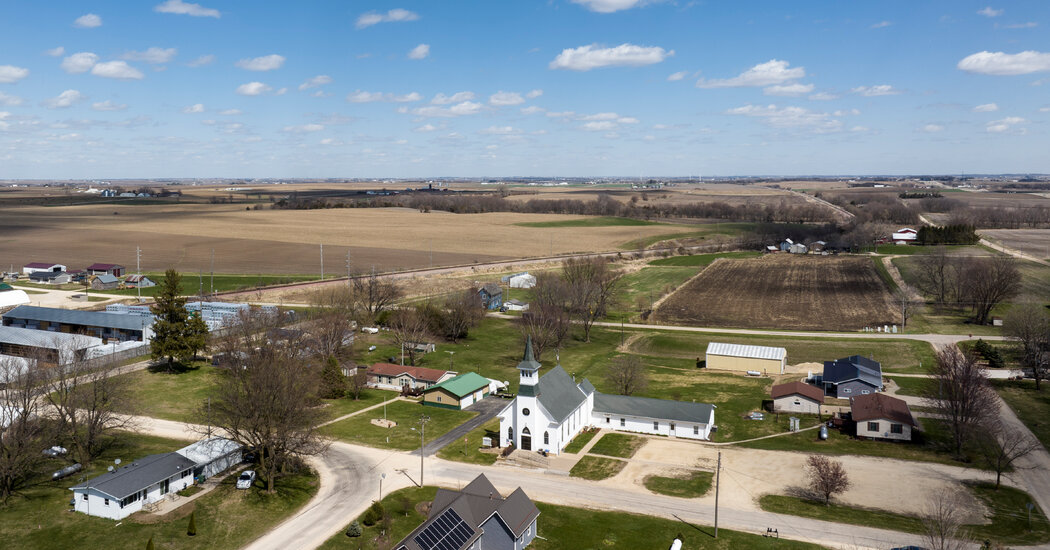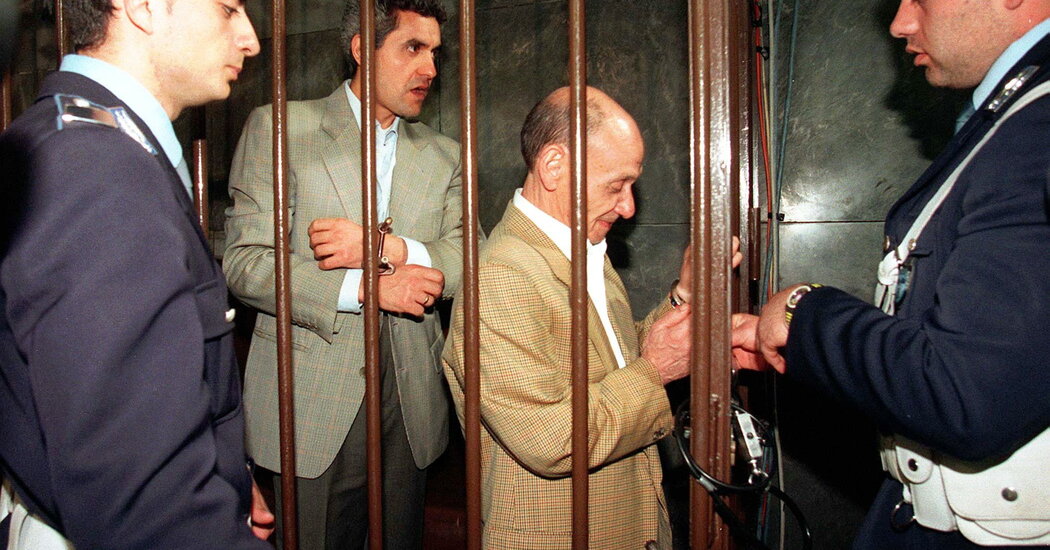Driving through the gently sloping terrain of northeast Iowa, there is little to distinguish Jim Conlan’s land, a stretch of light brown dirt sprinkled with tallgrass and maples, from the other fields where soybeans and cornstalks will soon sprout from the ground.
But if Mr. Conlan has his way, his plot in Delaware County will lead to a permanent change in how farmland is used across the country.
For 40 years, to remain eligible for federal crop insurance and other government programs, American farmers have been required to preserve wetlands on their properties. That federal provision, known as Swampbuster, has been credited by environmentalists with keeping countless acres of vulnerable land unplowed, and has been upheld over the decades by Republican and Democratic administrations.
But where conservationists see an essential guardrail against habitat destruction, Mr. Conlan sees government run amok.
Backed by legal groups that support libertarian causes, Mr. Conlan is challenging Swampbuster in federal court, asking not just to open nine acres of wetland in his field to cultivation, but to have that entire provision of federal law deemed unconstitutional. He is seeking to build on a series of recent court decisions that have reduced the role of federal agencies in regulating private land and have rolled back wetland protections.
“The bigger principle is that the federal government doesn’t have the authority to regulate private property,” said Loren Seehase, a lawyer at the Liberty Justice Center who is among those representing Mr. Conlan’s company, CTM Holdings.
Environmental groups, already reeling from a series of major court losses, have mobilized to defend Swampbuster, warning that millions of acres of protected wetlands could be in peril if the provision is invalidated.
The threat, they say, goes beyond wetlands. If the courts buy the legal theory that Mr. Conlan is pushing, they believe that other provisions, including one called Sodbuster that sets aside rural land that is considered highly erodible, could be in jeopardy in the future.
“This is a part of a reckless and dangerous assault on our bedrock environmental law,” said Dani Replogle, a lawyer for Food & Water Watch, a nonprofit advocacy group that has intervened in Mr. Conlan’s lawsuit against the federal Department of Agriculture. Ms. Replogle said her opponents were “essentially right-wing extremists who are trying to turn wetlands into a boogeyman for government overreach.”
The fight over Swampbuster is playing out against the backdrop of a Trump administration that has taken a skeptical approach toward many longstanding federal regulations, moving to loosen or discard rules on commercial fishing, coal production and the reporting of greenhouse gas emissions, among others.
Environmentalists have worried that federal officials might be newly sympathetic to efforts to invalidate Swampbuster. But so far, at least, U.S.D.A. lawyers have continued to defend Swampbuster in court and have questioned whether Mr. Conlan had properly appealed the wetland classification concerning his land. Agriculture Department officials did not respond to a request for comment about the legal fight.
When Swampbuster was passed as part of the 1985 Farm Bill, the country’s wetlands were disappearing rapidly, and policymakers were concerned that federal farm subsidies had given farmers an incentive to plant crops on any land they could, including sensitive habitats. Wetlands, defined by the government as lands that are covered by water or where water is present at or near the surface of the soil for at least part of the year, play an important role in storing and filtering water and are home to many species of plants and animals.
Swampbuster allowed farmers to continue planting on wetlands that had already been producing crops, but said that untouched wetlands had to remain crop-free if farmers wished to receive government benefits, including certain U.S.D.A. loans, subsidy payments, disaster assistance payments and federally subsidized crop insurance. Many farmers and landowners rely on those programs, which collectively cost taxpayers billions of dollars each year, to sustain their businesses and help them rebound from natural disasters.
Mr. Conlan, a lawyer and financier who grew up on an Iowa farm, said he had no intention of suing the government when he bought his roughly 72-acre property in 2022 on the outskirts of the town of Delaware, population 140. The land, part of which is wooded, borders a wastewater treatment facility and a four-lane highway, and the whir of speeding semi trucks drowns out the sound of chirping birds.
Scattered in patches around the property are a total of nine acres of wetlands, surrounded by drier ground where Mr. Conlan’s tenant has grown corn in recent years.
With thousands of vehicles buzzing by each day, Mr. Conlan, who splits his time between Chicago and Philadelphia, said he figured that the field he bought might eventually be developed for commercial uses, which would not be restricted by Swampbuster. In the short term, he would lease it out to a farmer to grow corn or soybeans, just as Mr. Conlan does with roughly 1,000 other acres of farmland he owns across Iowa.
Mr. Conlan’s tenant in Delaware County receives federally subsidized crop insurance for the crops he raises on the plot, one of Mr. Conlan’s lawyers said. The lawyer said he was unsure whether any of Mr. Conlan’s tenants benefit from U.S.D.A. programs other than crop insurance.
After acquiring the Delaware County land, Mr. Conlan said he became convinced that the nine acres classified as wetlands by the government, which he said are not visibly wet or connected to waterways, were not really wetlands at all. He raised the issue with U.S.D.A., which administers Swampbuster, and eventually decided to take the agency to court. Though he believes his land is wrongly classified, he also wants the entire Swampbuster provision declared unconstitutional.
“You can’t just take people’s property, give them no compensation and say, ‘tough luck,’” Mr. Conlan said.
Recent Supreme Court decisions have limited federal agencies’ environmental rule-making authority and helped open a lane to challenge Swampbuster. In 2023, the court said the Clean Water Act did not allow the Environmental Protection Agency to regulate discharges into wetlands near bodies of water unless the wetlands have “a continuous surface connection” to those waters. In 2022, the court limited the E.P.A.’s ability to regulate carbon emissions from power plants. One of the firms representing Mr. Conlan, the Pacific Legal Foundation, represented landowners in the 2023 wetlands case.
“From the Supreme Court, especially, there’s been a lot of changes in administrative law, and I think that makes courts more receptive to our arguments,” said Jeff McCoy, a lawyer for the Pacific Legal Foundation who is involved in the Swampbuster case.
The outcome of the case, Mr. Conlan’s lawyers said, should matter even to Americans who will never own an acre of farmland. Conditioning farm subsidies on a landowner promising to conserve wetlands, Ms. Seehase said, would be like requiring Social Security beneficiaries to sign a document relinquishing their right to own a gun, or conditioning food stamp eligibility on a promise to not speak negatively about the government.
While some farmers see Swampbuster as overreach, others see it as a reasonable and necessary protection. John Gilbert, a longtime corn, soybean and dairy farmer in Iowa, said he feared that there would be environmental and health consequences if Swampbuster were to disappear.
Mr. Gilbert is on the board of the Iowa Farmers Union, which has intervened in Mr. Conlan’s lawsuit. He said in court filings that “Swampbuster is the last thumb in the dike preventing total destruction of our natural ecosystems.”
“Farm programs are not entitlements,” Mr. Gilbert said in an interview, and it is “perfectly reasonable for the taxpayers to expect some minimal behavior standards for farmers” who receive federal funds.
For now, all sides are waiting to see how a federal district judge in Iowa rules in the case. The judge, C.J. Williams, who was appointed by Mr. Trump, heard arguments last month, and could announce a decision at any time.
There is a widespread expectation, though, that Judge Williams’s ruling, whatever it may be, will not be the final word. Lawyers on both sides said they would strongly consider appealing if they lost, and they expected their opponents to do the same.
#Swampbuster #Protects #Millions #Acres #Wetland #Threat










